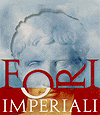Life in
Antique Rome
Cuisine
The kitchen table was the mirror of civilization
and culture, reflecting the cultivation of land and the transformation of produce. What
did the Romans eat? Sources from back then (Apicius, Juvenal, Petronius, Columella) have
passed down the details of ingredients and their preparation, including etiquette and
rituals. Here are some details, recipes, and methods used in the kitchen:
Ingredients
Not as we would have imagined, the Mediterranean diet back then lacked certain ingredients
that didn't arrive to Europe until after the discovery of America: tomatoes, peppers,
potatoes, rice, corn, and certain citrus fruits were non-existent. Even pasta didn't
exist, given that wheat served as a binder (starch) not as a staple to make spaghetti or
tagliatelle. But fish, meat, legumes, eggs, cereals, and cheese didn't stop Lucullus, for
example, from preparing large banquettes of exceptional quality.
Three daily meals
Getting up at dawn, the antique Romans had breakfast ("ientaculum")
with the leftovers from the previous evening (cheese, olives, bread, honey), fresh milk,
and small flat loaves of bread. The meal was substantial.
Around noon they had a small and quick lunch ("prandium") being that they were
at work in the city. Often they ate from street vendors and after had a bath. The food
varied from season to season; hot food in the winter, and fresh food in the summer.
Dinner ("cena") was tied to the hour of sunset with the presence of the whole
family and an abundant meal. During the very antique times they ate soup with legumes,
milk, cheese, fresh and dried fruit, and lard. As time evolved, bread made its debut and
meat was also served on the tables of the poor. When there were dinner guests, the meal
was a "convivium", with appetizers ("gustum"), large plates of food
("caput cenae"), and dessert ("mensa secunda"). There was also
delicacies like truffles, goose liver (thought of by Plinius), minced lobster-balls, and
oysters. Cattle meat was scarce since they were used for tilling the land. In compensation
every kind of wild game was available, with spiders and snails used for extra-fine
cuisine, like today. Always present were sauces and spices added to everything: pepper,
clove, saffron, mustard, fennel and anise seeds, juniper berry, fish, oil, vinegar, and
wine.
The kitchen
The kitchen was a small room without windows. There was a small oven for bread
and focaccia, a sink, and a sort of stone stove for wood or coal. Food was cooked in pans
made of silver or bronze.
The table
The dining room was called the "triclinio", the nicest room in the
house, splendidly decorated and furnished (marble, mosaic, frescoes, fountains, fish
tanks, tables with silver and flower inlays). In the triclinio, one entered with their
right foot and sat at their usual place, a 3 person bed for eating while lying down (the
popular people ate sitting however) like the Greeks. Food could be taken from a serving
dish or served by a slave in a personal plate that was held with the left hand and eaten
with the right, taking small bites to avoid spilling on oneself.
At the end of the meal, teeth were cleaned with toothpicks ("pinna"), of which
some were made of silver.
The conservation of food
Because of the mild climate and the heat in the summer months of Rome, there was a daily
problem of conserving food. There were diverse solutions:
- by smoking the food, usually done with cheese;
- by dehydrating, for many foodstuffs and meat;
- by spreading honey, on fresh fruit;
- by putting it under salt, after Tiberius constructed the "salinae".
Some antique recipes
Garum Sauce by Gargilio Marziale-III century (can be made today): 2 teaspoons of
anchovy paste diluted in condensed grape juice (grape juice can be boiled until it reduces
to 1/10th of the original quantity). Mix with a pinch of oregano.
Sauce for veal cutlets by Apicius- 281 A.D. (for 4 people): leave 200g of
pine nuts and 200g of shelled walnuts in Garum for one night; crush and then soften the
nuts in more garum. Add salt, pepper, thyme, oil, and vinegar upon serving.
Asparagus Soufflé by Apicius- 132 A.D. (for 4 people): break up 2kg of
asparagus into small pieces and strain; mix aside-pepper, garum, a glass of wine, and 3
teaspoons of oil and fry together with asparagus. Add 6 eggs to the creamed asparagus.
Spread a casserole pan with the asparagus mixture and place 4 chicken breasts sprinkled
heavily with pepper. Cook until ready.
Meat-balls by Apicius- 48 A.D. (for 4 people): Combine 500 grams of diced
pork or beef with 150 grams of bread crumbs soaked in wine. Add pepper, a teaspoon of
garum, and 500 grams of pine nuts. Make into meat-balls and cook in a glass of wine.
There will soon be other recipes to try!
> The men
> The women
> The houses
> Live images from Rome
through the remote control camera
> Places and
constructions as seen today and as seen during Antique Rome
In the other chapters you can find: the latest
news on excavation advancements in the Imperial Forum area, the history of Rome, sayings
and habits of the Antique Romans. Select a chapter among the four titles in the black
column on the right.
|



